The 39 Most Common Florida Caterpillars: A Visual Identification Guide
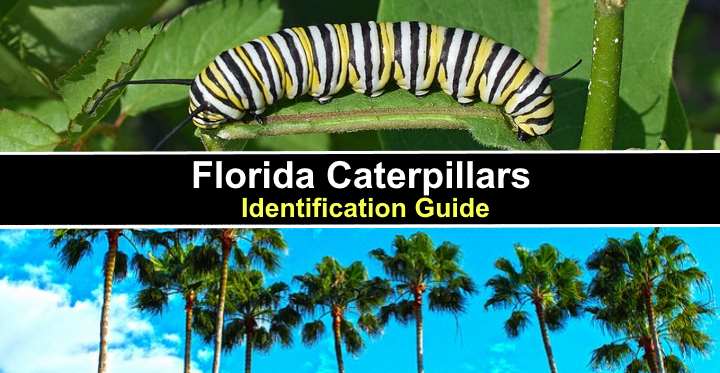
Florida is home to many types of caterpillars. Among Florida’s exotic and strange-looking caterpillars are fuzzy, striped, and unusual-looking horned caterpillars. In addition, several varieties of stinging caterpillars in the Sunshine State can give you a nasty sting if you handle them. Identifying caterpillars in Florida can help to know which species of caterpillars are poisonous and which are harmless.
Caterpillars are the larvae of moths and butterflies. Caterpillars hatch from eggs and develop into worm-like crawling insects with four sets of prolegs, six forelegs, and a segmented body. Depending on the species, caterpillars can have striped, dotted, or mottled patterns. Additionally, caterpillars in Florida can be green, yellow, black, or multi-colored.
It can be challenging to identify some Florida caterpillar species. As the plump caterpillars devour plant leaves, they go through various stages called instars. As a result, some immature caterpillars may look completely different from mature caterpillars before entering the pupal stage.
This article is an identification guide to Florida’s exotic, scary, stinging, horned, furry, and smooth-bodied caterpillars.
How to Identify Caterpillars in Florida
You can identify caterpillars by their size, body type (hairy or smooth), body patterns, and the presence of horns. Some southern caterpillars have tentacle-like spikes to help with identification. To spot poisonous Florida caterpillars, look for a fuzzy body with stinging spines. Remember, not all furry caterpillars are poisonous.
Some types of caterpillars are easy to identify because of their host plants. For example, many caterpillars only feed on specific types of shrubs, plants, or trees.
Types of Caterpillars in Florida (With Pictures) – Identification Guide
Cloudless Sulphur Caterpillar (Phoebis sennae)
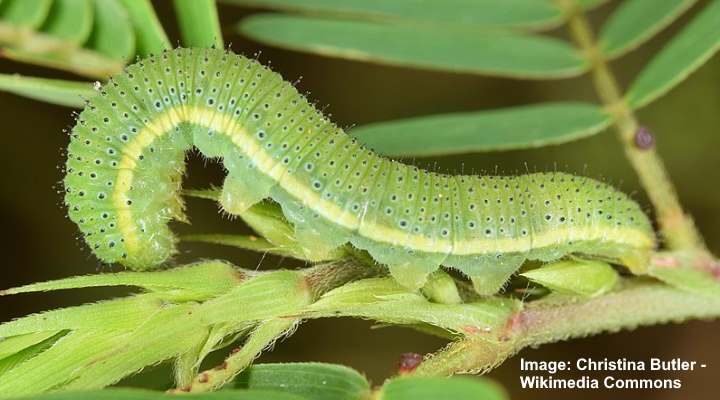
Cloudless Sulphur caterpillar (Phoebis sennae)
The cloudless sulphur caterpillar is a light green caterpillar with black raised dots producing small spines. Looking up close, you see that soft yellowish spines cover the prolegs and caterpillar abdomen. This green Florida caterpillar has a pale-yellow stripe running along its sides.
A characteristic feature of the cloudless sulphur caterpillar is that its color changes depending on its food. For example, the long, plump caterpillar is light green when feeding on green foliage. However, it becomes yellow when munching on yellow leaves.
Florida Caterpillar Identification
To identify the cloudless sulphur caterpillar, look for a green body with bluish-black dots, light yellowish short spines, and a yellow lateral band along its sides. The cloudless sulphur caterpillar grows 1.6” to 1.8” (4 – 4.5 cm) in length.
- Adult Stage: Cloudless Sulphur (Phoebis sennae) – This striking butterfly exhibits bright yellow wings with a prominent and swift flight, typically spanning 2.5 to 3 inches in width.
- Host Plants: Candle Bush (Cassia alata) and Senna plant (Cassia senna).
Long-Tailed Skipper Caterpillar (Urbanus proteus)
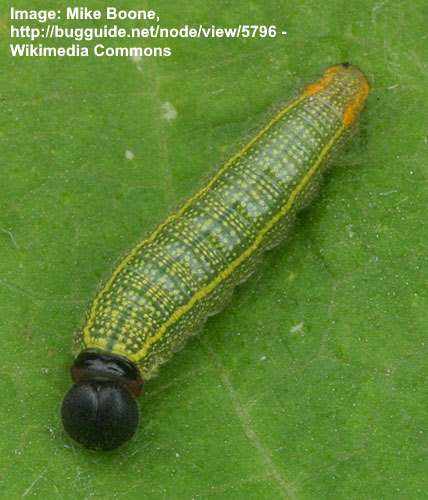
Long-Tailed Skipper Caterpillar (Urbanus proteus)
The long-tailed skipper caterpillar is a large green slug-like caterpillar with rings of yellow dots around its segments and lateral greenish-yellow green lines running the length of its back. Also called the bean leafroller, an identifying feature of the green caterpillar is its black or burgundy globular head and orange patterns at its tail.
As the long-tailed skipper caterpillar matures, its body becomes pale green, and it develops pinkish patterns.
Florida Caterpillar Identification
Identify the long-tailed skipper caterpillar by its black ball-like head, yellow markings on its body in the form of lines and dots, and orange prolegs.
- Adult Stage: Long-tailed Skipper (Urbanus proteus) – A medium-sized butterfly with brown wings, featuring a distinctive white band and long tails. It is known for its quick and erratic flight pattern.
- Host Plants: Long-tailed Skipper caterpillars feed on legumes, including plants such as beans, peas, and other members of the Fabaceae family.
Zebra Longwing Caterpillar (Heliconius charithonia)
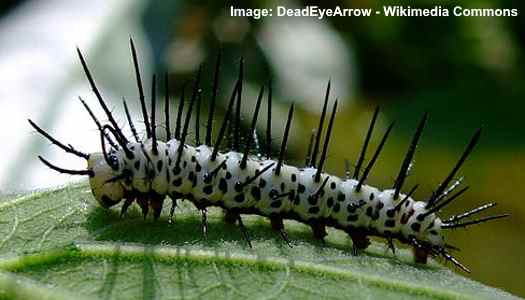
Zebra Longwing Caterpillar (Heliconius charithonia)
The zebra longwing caterpillar is a pale gray crawling insect with long black fleshy spikes often found in the southern United States. Close-up pictures of the zebra longwing show the pointed black spikes are covered in fine spines.
This black and gray caterpillar feeds on passionflower foliage that helps it develop toxic compounds. These make the zebra longwing poisonous and foul-tasting to predators.
Caterpillar Identification
The protruding spikes on the zebra longwing caterpillar make it easy to identify. The caterpillar grows 0.5” (1.2 cm) long.
- Adult Stage: Zebra Longwing (Heliconius charithonia) – A medium-sized butterfly featuring elongated black wings with bold yellow stripes, resembling a zebra’s pattern. It has a slow and graceful flight.
- Host Plants: Zebra Longwing caterpillars primarily feed on passionflowers (Passiflora spp.), using them as their main food source.
Forest Tent Caterpillars (Malacosoma disstria)

Forest Tent Caterpillar (Malacosoma disstria)
The southern US is home to many species of tent caterpillars, including the forest tent caterpillar. The spiny caterpillar has a dark body with lateral blue bands, yellow lines, and white patches. You will also notice feathery spines along the caterpillar’s sides.
Also called tent worms, forest tent caterpillars are easy to identify in spring and summer when they are active. The fuzzy caterpillars congregate en masse on apple trees, as well as willow, oak, elm, birch, and maple trees.
Florida Caterpillar Identification
To identify tent worms, look for blackish-brown worm-like caterpillars with blue, black, and yellow lines running lengthwise on their back with an irregular white pattern on each segment. Hairy forest tent caterpillars mature at 2.5” (6.5 cm) long.
- Adult Stage: Forest Tent Caterpillar Moth (Malacosoma disstria) – A medium-sized moth with a wingspan of approximately 3-5 cm. It has brownish-grey wings with two parallel lines running across each forewing.
- Host Plants: Forest Tent Caterpillar caterpillars feed on a variety of deciduous trees, including but not limited to oak, aspen, birch, and maple.
Luna Moth Caterpillar (Actias luna)
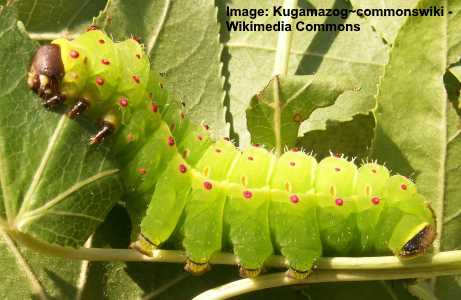
Luna Moth Caterpillar (Actias luna)
The luna moth caterpillar is a light green crawling insect with a plump body, red dots, and tufts of small spines. Luna moth caterpillars have a characteristic habit of raising the front part of their body. You can identify luna moth caterpillars feeding on walnut, hickory, birch, and alder trees.
Florida Caterpillar Identification
To identify the luna moth caterpillar, look for its brown head, lines of bright red dots running along its light green body, four pairs of large prolegs, and three pairs of brown forelegs. The luna moth caterpillar grows to 3.5” (9 cm) in length.
- Adult Stage: Luna Moth (Actias luna) – A large and bright green moth with a wingspan that can reach up to 4.5 inches. It is characterized by its long, delicate tails and striking eyespots on its wings.
- Host Plants: Luna Moth caterpillars feed on the leaves of various deciduous trees, including but not limited to birch, sweet gum, hickory, and walnut.
Cabbage Looper Caterpillars (Trichoplusia ni)
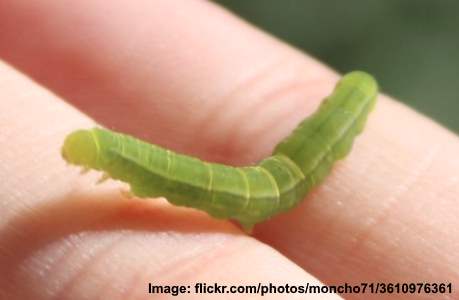
Cabbage Looper Caterpillar (Trichoplusia ni)
The cabbage looper is a green caterpillar common to Florida. The characteristic trait of the small cabbage loopers is the arching or looping movements they make when crawling on plants. In addition, the small green caterpillars have yellowish-green bands separating the segments. Cabbage looper caterpillars have a voracious appetite and can devour three times their body weight in a day.
Florida Caterpillar Identification
Cabbage looper caterpillars are identifiable by their thin lime-green or yellowish-green body and arching action when moving. Cabbage looper caterpillars grow up to 1.5” (4 cm).
- Adult Stage: Cabbage Looper Moth (Trichoplusia ni) – A medium-sized moth with mottled brown wings featuring a distinctive silver figure-eight mark.
- Host Plants: Cabbage Looper caterpillars feed on a variety of plants, including cruciferous vegetables such as cabbage, broccoli, and cauliflower, along with other crops like lettuce and potatoes.
Cecropia Moth Caterpillar (Hyalophora cecropia)
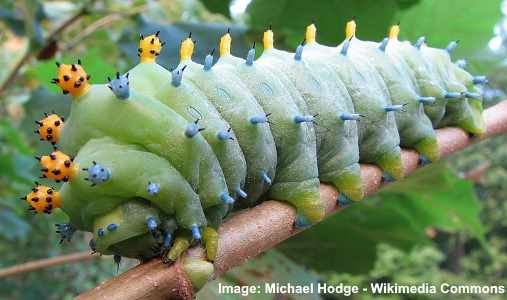
Cecropia Moth Caterpillar (Hyalophora cecropia)
One of the unusual caterpillars you’ll find in Florida is the cecropia moth caterpillar. The identifiable features of the cecropia caterpillar are its large, ridge-like segments, blue and orange tubercles with black spikes, and a lime green body.
Despite being a bizarre-looking green caterpillar, the large, plump caterpillar turns into one of Florida’s most beautiful brown moths.
Florida Caterpillar Identification
The Florida cecropia moth caterpillar, is an easy-to-identify fat caterpillar that has pronounced segments with rows of blue and yellow fleshy bumps, black spikes, and several orange tubercles at its head. Cecropia moth caterpillar grows around 4.5” (10 cm) long.
- Adult Stage: Cecropia Moth (Hyalophora cecropia) – A large, spectacular moth with reddish-brown wings bordered by bands of white, red, and tan. It has eye-catching, crescent-shaped eye spots on its hindwings.
- Host Plants: Cecropia Moth caterpillars feed on the leaves of trees such as maple, birch, cherry, apple, and boxelder.
Florida Tiger Swallowtail Caterpillar (Papilio glaucus)
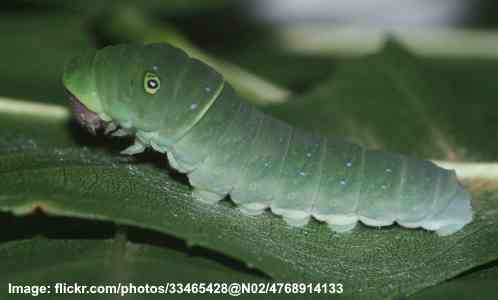
Tiger Swallowtail Caterpillar (Papilio glaucus)
The tiger swallowtail is an unusual caterpillar due to its dark green body, smooth surface, and distinctive eyespots on its head. The eye markings are black dots with a white center and light green ring around it. This is a defensive characteristic of some caterpillars to scare off predators.
Another unusual feature to identify the tiger swallowtail caterpillar is its defensive organ (osmeterium) on its head. This appears when the caterpillar is threatened, and it looks like a forked snake’s tongue. The caterpillar is also mildly toxic to birds and other predators.
Florida Caterpillar Identification
The identifiable feature of the tiger swallowtail is its strange eye-like markings on either side of its head.
- Adult Stage: Eastern Tiger Swallowtail (Papilio glaucus) – A large and striking butterfly with black stripes and vivid yellow wings, featuring blue and orange spots near the tail.
- Host Plants: Eastern Tiger Swallowtail caterpillars feed on a variety of trees, including wild cherry, tulip tree, ash, and cottonwood.
Forester Moth Caterpillar (Zygaenidae)
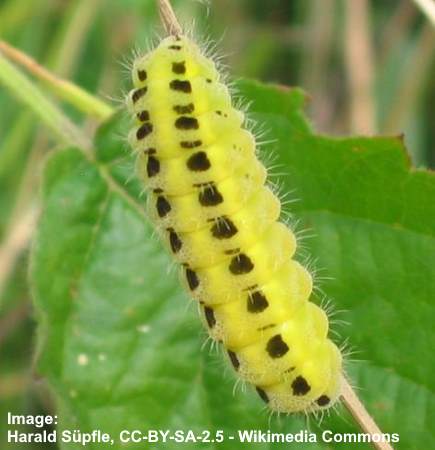
Yellow Florida Forester Moth Caterpillar (Zygaenidae)
The forester moth caterpillar is a bright yellow or yellowish-green caterpillar with two rows of black dots on its back. You will also notice that the yellow forester moth larvae have spiny tufts on their back and sides. You can often spot forester moth caterpillars feeding on herbaceous plants in Florida.
Florida Caterpillar Identification
To identify the forester moth caterpillar, look for a bright yellow caterpillar with black markings along its back and sides. Forester moth caterpillars grow up to 4.7” ( 12.5 cm) in their final instar.
- Adult Stage: Forester Moth – A member of the Zygaenidae family, the Forester Moth is characterized by its vibrant colors and distinct markings, often found in meadows, grasslands, and woodland edges.
- Host Plants: Forester Moth caterpillars typically feed on various herbaceous plants and shrubs, depending on the specific species and habitat.
- Stinging: Some species of Forester Moth caterpillars may possess urticating hairs or other defense mechanisms, which can cause skin irritation in some individuals. However, not all Forester Moth caterpillars have stinging capabilities, and their impact can vary depending on the species.
Evergreen Bagworm (Psychidae)

Bagworm larvae carry around their cocoon
Bagworms are unusual types of shiny black or dark brown caterpillars that are difficult to spot. The easiest way to identify bagworms on trees in Florida is by the protective cocoon bags they live in. A large infestation of bagworms can quickly defoliate trees.
Florida Caterpillar Identification
Bagworms are identified by the bag-like structures measuring 0.4” to 6” (1 to 15 cm) long and made from tree foliage. Mature bagworms can grow up to 1” (2.5 cm) long.
- Adult Stage: The Evergreen Bagworm is a type of moth belonging to the Psychidae family.
- Host Plants: Bagworms tend to infest evergreens such as arborvitae, junipers, cedars, and spruce trees. However, bagworms will also decimate deciduous trees such as maple, willow, poplar, and oak. Bagworms can infest up to 130 different species of trees and shrubs.
Polyphemus Moth Caterpillar (Antheraea polyphemus)

Polyphemus moth (Antheraea polyphemus)
The polyphemus moth caterpillar is a type of green, silk-spinning caterpillar found in Florida. Polyphemus moth caterpillars have a bright green, plump body with bright red dots in bumps around each segment. Pictures of polyphemus moth caterpillars show they have spines emerging from the tiny red tubercles.
Like many types of caterpillars, the polyphemus moth caterpillars look slightly different in each instar. They emerge from eggs bright yellow and gradually become green during each stage.
Florida Caterpillar Identification
The identifiable traits of the polyphemus moth caterpillar are a bright green, almost translucent body and rows of bright red or silver spiny dots around its segments. The polyphemus moth caterpillar grows 3” to 4” (7.6 – 10 cm) long.
- Adult Stage: Antheraea polyphemus, also known as the Polyphemus Moth, is a North American silk moth recognized for its large, reddish-brown wings with distinct eye-shaped markings resembling the mythological Cyclops Polyphemus.
- Host Plants: Polyphemus Moth caterpillars feed on a variety of deciduous trees such as maple, oak, birch, willow, and other broadleaf trees.
Florida Red Admiral Caterpillar (Vanessa atalanta)
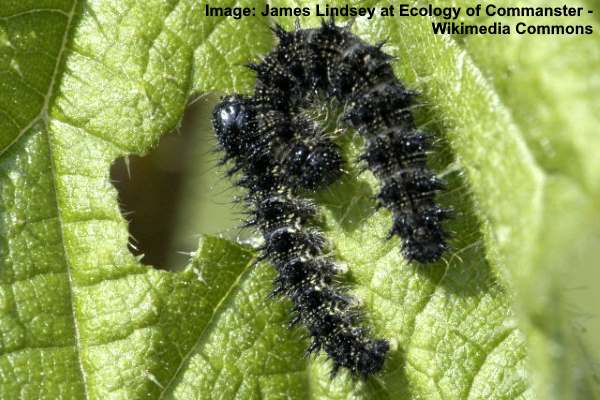
Red Admiral Caterpillar (Vanessa atalanta)
The red admiral is a spiky black caterpillar that has identifiable fleshy spines and white tiny dots. As the jaggy-looking caterpillar develops, it gradually becomes grayish-brown with dark red or brown dots along its sides. You can find red admiral caterpillars feeding on stinging nettle leaves.
After emerging from the pupa, the once spiky black caterpillar becomes a stunning black and red butterfly.
Florida Caterpillar Identification
The characteristics of the red admiral caterpillar that helps identify it are a shiny black body covered in bands of spiny spikes. Red admiral caterpillars grow 1” (2.5 cm) long.
- Adult Stage: Vanessa atalanta, commonly known as the Red Admiral, is a medium-sized butterfly with dark brown wings featuring striking red-orange bands and white spots along the tips. It is known for its distinctive, rapid flight pattern.
- Host Plants: Red Admiral caterpillars primarily feed on various nettles (Urtica spp.) and false nettles (Boehmeria cylindrica), which serve as their main food source during their larval stage.
Redhumped Caterpillar (Schizura concinna)
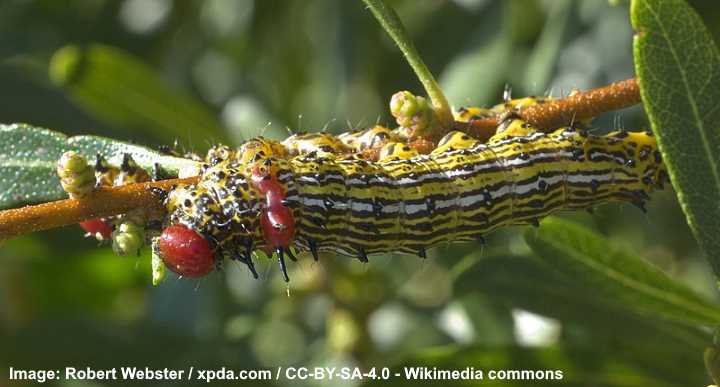
Redhumped Caterpillar (Schizura concinna)
The redhumped caterpillar gets its name from the distinctive red humps on its black, yellow, and white striped body. Other features of the redhumped moth caterpillar are its cherry-red round head, soft horn-like growths, and light, feathery spines. In Florida, you can see these striped caterpillars on fruit trees, cottonwood, walnut, and willow trees.
Florida Caterpillar Identification
To identify the redhumped caterpillar, look for its characteristic black and white stripes on a yellow body, black fleshy tentacles, and a band of red bumps around its thorax.
- Adult Stage: Schizura concinna is a species of moth known as the Redhumped Caterpillar Moth. It features brownish-gray forewings with intricate patterns and distinctive red markings near the thorax.
- Host Plants: Redhumped Caterpillar Moth caterpillars feed on a variety of deciduous trees, including but not limited to oak, hickory, walnut, and cherry.
Spicebush Swallowtail Caterpillar (Papilio Troilus)
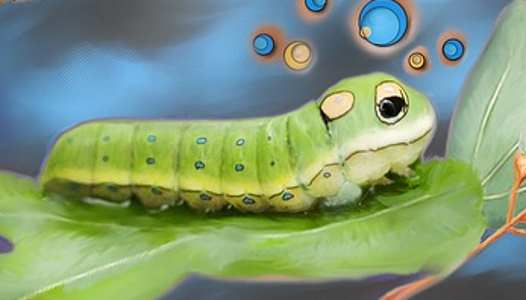
Spicebush Swallowtail Caterpillar (Papilio Troilus)
One of the strangest green caterpillars you’ll find in Florida is the spicebush swallowtail larvae. Its instantly recognizable feature is the large eye markings on its head. The black circles surrounded by a yellow ring and white pattern create false eyespots with a reflection. There are also blue circular patterns on its segments.
The spicebush swallowtail caterpillar changes from brown to green and then yellowish-green.
Florida Caterpillar Identification
Identifying the spicebush swallowtail caterpillar is easy due to its large eyespots, black and blue dots, and a dark line along its side. Fully grown, swallowtail caterpillars measure 2.1” (5.5 cm) long.
- Adult Stage: Papilio troilus, commonly known as the Spicebush Swallowtail, is a medium-sized butterfly featuring black wings with striking blue-green iridescence, along with prominent orange spots and bands.
- Host Plants: Spicebush Swallowtail caterpillars primarily feed on plants from the Lauraceae family, including spicebush (Lindera benzoin) and Sassafras (Sassafras albidum).
Striped Caterpillars in Florida (With Pictures) – Identification Guide
Black and Orange Florida Gulf Fritillary Caterpillar (Dione vanillae)
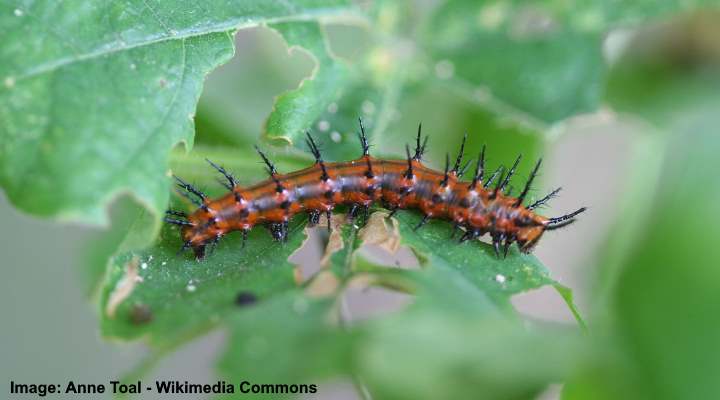
Gulf Fritillary Caterpillar (Dione vanillae)
The gulf fritillary caterpillar is an orange caterpillar with spiny spikes around each segment. The orange gulf fritillary caterpillar also has grayish-black stripes running longitudinally along its back. In Florida, you’ll find this small, slender black and orange caterpillar munching through Passiflora plant foliage.
Florida Caterpillar Identification
A gulf fritillary caterpillar has distinctive spines poking out from a smooth orange body with a blackish stripe. Gulf fritillary caterpillars mature at 0.5” (1.2 cm) in length.
- Adult Stage: Dione vanillae, also known as the Gulf Fritillary, is a medium-sized butterfly featuring bright orange wings with black markings and three silver-white spots on each forewing.
- Host Plants: Gulf Fritillary caterpillars primarily feed on plants from the Passifloraceae family, including various passionflowers, which serve as their main food source during their larval stage.
Azalea Caterpillars (Datana major)
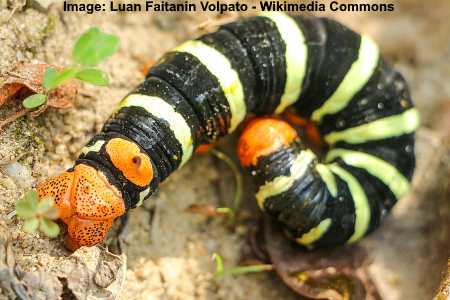
Azalea Caterpillar (Datana major)
The azalea caterpillar is a black caterpillar with bright green bands around its plump, smooth body. The recognizable feature of an azalea caterpillar is its round orange head and tail section. The green and black stripes and orange markings make the voracious larvae easy to spot on azaleas, rhododendrons, and apple trees.
Florida Caterpillar Identification
It’s easy to identify an azalea caterpillar due to its rusty brown or orange oval head, black and green stripes, and brownish-orange tail end. The striped caterpillars grow up to 2” (5 cm) long.
- Adult Stage: Datana major transforms into a medium-sized brown moth during its adult stage, characterized by its relatively inconspicuous appearance.
- Host Plants: Major Datana caterpillars feed on a variety of deciduous trees, including but not limited to oak, hickory, elm, and maple.
Monarch Caterpillar (Danaus plexippus)

Monarch Caterpillar (Danaus plexippus)
The monarch caterpillar is a type of striped, horned Florida caterpillar that has black, white, and yellow colors. The beautiful caterpillar has colorful bands wrapping around each segment. You will also notice two characteristic black long horns at the head end and two shorter horn-like tails.
Look closely at the monarch caterpillar, and you’ll notice white dots on its prolegs and black forelegs.
Florida Caterpillar Identification
The monarch caterpillar is easy to identify due to its black, yellow, and white stripes wrapping around its body. The caterpillar grows up to 2” (5 cm) long.
- Adult Stage: Monarch butterfly – a large and iconic butterfly species with vibrant orange wings featuring black veins and white spots along the edges.
- Host Plants: Monarch butterfly caterpillars primarily feed on milkweed plants (Asclepias spp.), using them as their main food source during their larval stage.
Black Swallowtail Caterpillar (Papilio polyxenes)
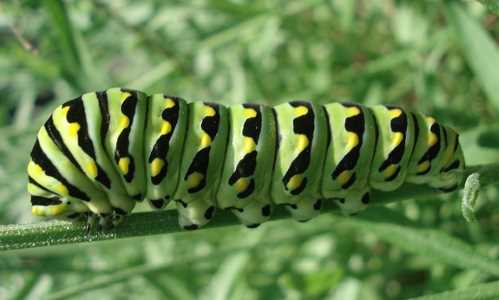
Black Swallowtail Caterpillar (Papilio polyxenes)
The Black Swallowtail (Papilio polyxenes) caterpillar is predominantly green with striking black and yellow bands along its body. The bright green striped caterpillar also has a characteristic of displaying an orange forked gland and releasing a foul odor when threatened. The caterpillar has a pair of false eyes near its head, contributing to its unique and intricate visual pattern.
The black swallowtail caterpillar doesn’t have any horns, spikes, or spines on its smooth body. You’ll find black swallowtail caterpillars on their host plants, milkweed, and parsley.
Its bright green and yellow colors and black stripes act to ward off predators. Another defensive mechanism is its defensive organ osmeterium—a forked tongue-like structure that appears behind its head when threatened.
Florida Caterpillar Identification
The identifiable features of the black swallowtail are its green body with black, yellow-dotted bands around each of its segments.
- Adult Stage: Papilio polyxenes, also known as the Black Swallowtail, is a medium-sized butterfly with black wings featuring striking yellow spots and a row of smaller blue spots near the edges.
- Host Plants: Black Swallowtail caterpillars feed on various plants from the Apiaceae family, including parsley, dill, fennel, and carrot tops, serving as their primary food source during their larval stage.
Queen Butterfly Caterpillar (Danaus gilippus)

Queen Butterfly Caterpillar (Danaus gilippus)
The queen butterfly caterpillar is a black and white striped caterpillar with yellow dots on its back and sides. You’ll notice that the stripy caterpillar has six large fleshy tentacles—two pairs near its head and two shorter “horns” at its tail end.
Florida Caterpillar Identification
To identify the queen butterfly caterpillar, look for recognizable black and white stripes in between black bands with two yellow markings. The six horn-like structures are black with red coloring at the base. Queen butterfly caterpillars grow 2” (5 cm) long.
- Adult Stage: Danaus gilippus, commonly known as the Queen butterfly, is a medium-sized butterfly with striking orange-brown wings featuring black and white markings and distinct veins.
- Host Plants: Queen butterfly caterpillars primarily feed on milkweed plants (Asclepias spp.) and other members of the Apocynaceae family, which serve as their primary food source during their larval stage.
Eight-Spotted Forester Caterpillar (Alypia octomaculata)
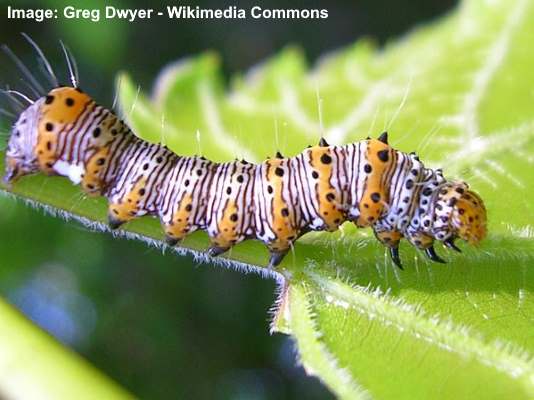
Eight-Spotted Forester Caterpillar (Alypia octomaculata)
The eight-spotted forester larva is an orange caterpillar with bands of white and black stripes around its body. Each of the body segments features black tubercles that look like small round dots. You’ll also notice feathery spines on this striped Florida caterpillar. The caterpillar has four sets of black prolegs and three sets of pointed forelegs.
Florida Caterpillar Identification
The characteristic traits of the eight-spotted forester caterpillar are thick black-spotted orange stripes, tufts of thin spines, and white and black stripes.
- Adult Stage: Alypia octomaculata is commonly known as the Eight-Spotted Forester moth. It features black forewings marked with eight distinctive white spots and orange hindwings.
- Host Plants: The caterpillars of the Eight-Spotted Forester moth feed on various plants, including grapevines and Virginia creeper, using them as their main food source during their larval stage.
Common Pine Sawfly (Diprion pini)
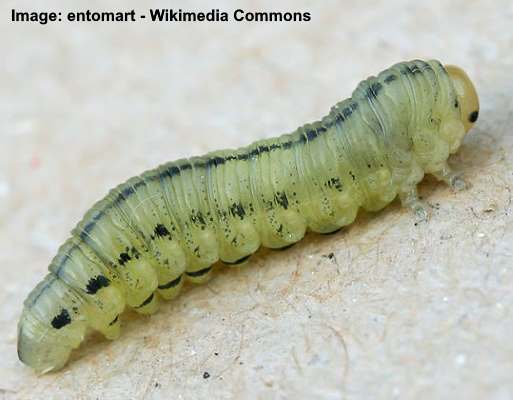
Common Pine Sawfly (Diprion pini)
The larva of the common pine sawfly is a light green caterpillar with a line of black dots along each side and a single black line along its back. As the green larva matures, its pale-yellow translucent head with fake eyespots turns a rusty-red color.
Unlike other caterpillars in this list, Diprion pini is not from the moth or butterfly order Lepidoptera. Instead, it is the larvae of the pine sawfly—a brown, winged insect that looks like a type of wasp.
Florida Caterpillar Identification
The pine sawfly caterpillar is identified by its pale green body and black markings in rows along its sides and back.
- Adult Stage: Diprion pini is a species of sawfly commonly known as the pine sawfly. The adult sawflies resemble wasps and are not classified as moths or butterflies.
- Host Plants: Pine sawfly caterpillars feed on various species of pine trees, including Scots pine, red pine, and jack pine, using them as their primary food source during their larval stage.
- Stinging: Pine sawfly caterpillars can defend themselves by regurgitating irritating fluids or using their mandibles to bite, but they do not have stinging capabilities.
Horned Caterpillars in Florida (With Pictures) – Identification Guide
White Admiral Caterpillar (Limenitis arthemis)
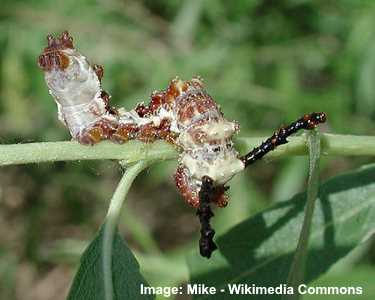
White Admiral Caterpillar (Limenitis arthemis)
The white admiral caterpillar is a Florida caterpillar that looks like bird poop. The unusual caterpillar has a light green and brown body with white blotches. An identifiable trait of this jaggy-looking caterpillar is its two long black horns on its head.
In Florida, you’ll often find the white admiral caterpillar feeding on willow, aspen, cherry, and birch trees. Despite its ugly appearance, the brown and white caterpillar turns into a spectacular butterfly with iridescent blue and orange colors.
Florida Caterpillar Identification
Identification of the white admiral caterpillar is by its brownish-olive body with white, uneven blotches on its back and along its sides. Compared to other caterpillars, white admiral larvae have thick, spiny horns at their head. The brown and white caterpillar grows up to 1.6” (4 cm) long.
- Adult Stage: Limenitis arthemis, commonly known as the Red-Spotted Purple, is a medium-sized butterfly with dark blue-black wings featuring iridescent blue markings, white spots, and red-orange spots near the margins.
- Host Plants: Red-Spotted Purple caterpillars feed on various plants, including cherry, willow, poplar, and birch, using them as their main food source during their larval stage.
Tomato Hornworm (Manduca quinquemaculata)
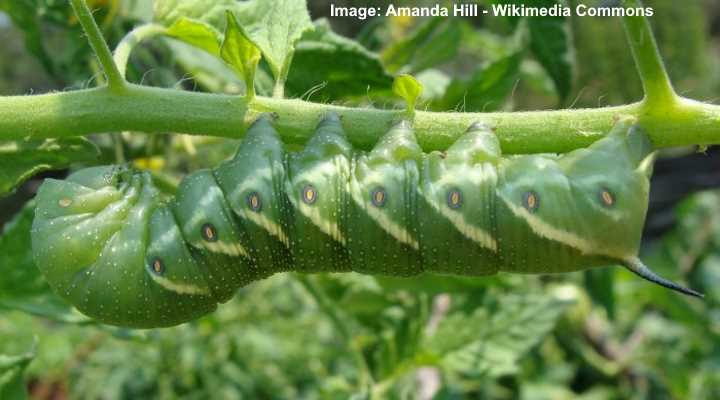
Tomato Hornworm (Manduca quinquemaculata)
The tomato hornworm is a bright green caterpillar with V-shaped markings and a row of eye-like markings along its sides. This horned caterpillar species has a pointed black projection at its tail end resembling a horn. Like many hornworm caterpillars, it has an oversized head.
As its name suggests, tomato hornworms gorge on tomato plant foliage. The caterpillars have an insatiable appetite and can quickly defoliate tomato plants. Unfortunately, because of their green coloring, tomato hornworms can be difficult to spot under tomato leaves.
Florida Caterpillar Identification
To identify a tomato hornworm, look for the characteristic pale yellowish ‘V’ markings and eyespots along each of its sides. The tomato hornworm is around 4” (10 cm) in length from its large head to its horned tail.
- Adult Stage: Manduca quinquemaculata is a species of large moth known as the Tomato Hornworm or the Five-Spotted Hawkmoth.
- Host Plants: Tomato Hornworm caterpillars primarily feed on plants from the Solanaceae family, including tomato, pepper, eggplant, and potato plants, using them as their main food source during their larval stage.
Hickory Horned Devil Caterpillar (Citheronia regalis)
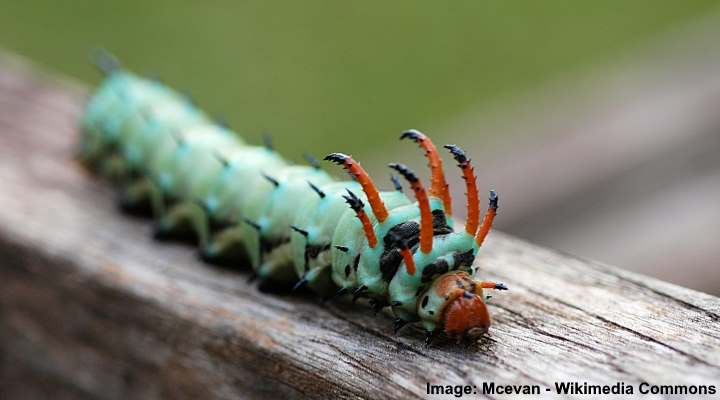
Hickory Horned Devil Caterpillar (Citheronia regalis)
One of the scariest-looking caterpillars in Florida is the hickory horned devil caterpillar. The giant horned caterpillar has a bluish-green body, curved spiny red horns with black tips, orangey-red head, and black spines on its body. Despite its fearsome look, this green caterpillar is entirely harmless.
The hickory horned devil gets its name from the menacing red horns at its head. Additionally, you often find it feeding on hickory leaves in Florida. This caterpillar is one of the largest moth larvae, and it turns into one of the biggest moths in the US—the regal moth.
Florida Caterpillar Identification
It’s easy to identify a hickory horned devil caterpillar due to its characteristic arched red and black horns, black spiny spikes, and bluish-green appearance. Hickory horned devil caterpillars can grow up to 5.5” (14 cm) long.
- Adult Stage: Citheronia regalis is a species of large silk moth commonly known as the Regal Moth or the Royal Walnut Moth.
- Host Plants: Regal Moth caterpillars primarily feed on the leaves of various trees, including but not limited to walnut, hickory, and sweetgum.
Imperial Moth Caterpillar (Eacles imperialis)
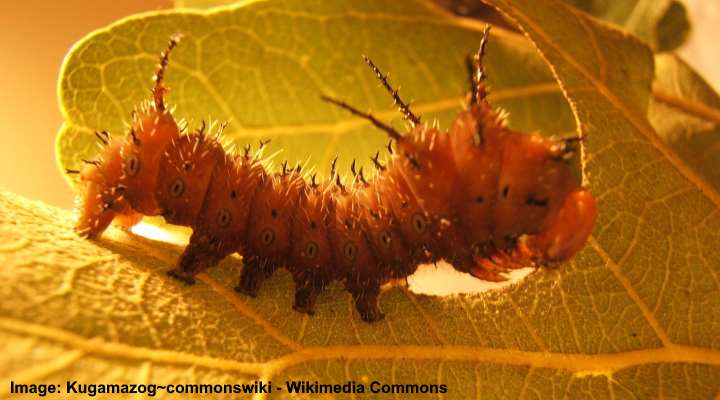
Imperial Moth Caterpillar (Eacles imperialis)
The imperial moth caterpillar is a horned caterpillar with long spiky horns at its head and a jaggy tail-like protrusion at its rear end. An imperial moth caterpillar can be tricky to identify because it can be orange with spiny hairs, green with orange horns, or brown with yellow dots and clumps of spines.
As the imperial moth caterpillar goes through its instars, it gradually becomes darker and hairier. Finally, when it’s ready to pupate, the larvae can either be dark brown or dark green.
Florida Caterpillar Identification
A mature imperial moth caterpillar is identified by its spiky appearance with hairs and spines covering its body. In addition, look for the four horns at the head and a tail at its rear. The caterpillars also have the trait of raising their front end when feeding. These large green or orange-brown caterpillars grow 3” to 5.5” (7.5 – 10 cm) long.
- Adult Stage: Eacles imperialis is a species of large silk moth commonly known as the Imperial Moth. It is recognized for its impressive wingspan and attractive coloration, featuring various shades of purple, brown, and yellow.
- Host Plants: Imperial Moth caterpillars primarily feed on the leaves of a variety of trees, including but not limited to pine, maple, oak, and sweetgum.
Pipevine Swallowtail Caterpillar (Battus philenor)
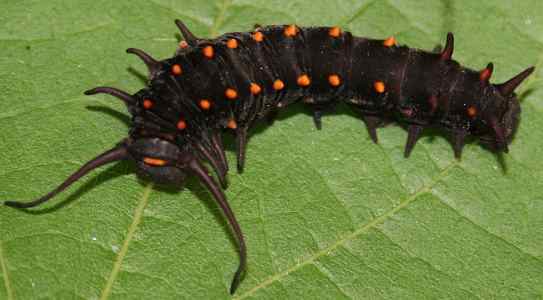
Pipevine Swallowtail Caterpillar (Battus philenor)
The pipevine swallowtail caterpillar is a dark-brown, almost black caterpillar with fleshy horns at its head, tail, and sides. Other traits of the pipevine swallowtail caterpillar are two rows of bright orange dots along its back. The dark-colored caterpillar has fine hairs covering its body, giving it a velvety appearance.
Florida Caterpillar Identification
A pipevine swallowtail caterpillar larva is easy to identify due to its black appearance, brightly-colored orange dots, and fleshy tentacle-like horns. Pipevine swallowtail caterpillars grow 2” (5 cm) long.
- Adult Stage: Battus philenor, commonly known as the Pipevine Swallowtail, is a medium-sized butterfly with distinctive black wings featuring iridescent blue scaling and white or light blue spots.
- Host Plants: Pipevine Swallowtail caterpillars feed on various species of pipevine (Aristolochia spp.), using them as their main food source during their larval stage.
- Stinging: The Pipevine Swallowtail caterpillar can sequester toxic compounds from its host plants, making it unpalatable to predators.
Tobacco Hornworm (Manduca sexta)

Tobacco Hornworm (Manduca sexta)
The green horned tobacco hornworm caterpillar is a plump larva with a light green body, eyespot markings, and white diagonal stripes along its sides. Another feature of the tobacco hornworm caterpillar is its rear horn, which is brown, green, or orange. You’ll find tobacco hornworms feeding on tomato plants and other nightshade crops.
Tobacco hornworm caterpillars look like tomato hornworms. To tell the two species apart, look at the markings on its side. Tobacco hornworms have a diagonal line, not the characteristic V-shape of the tomato hornworm.
Florida Caterpillar Identification
Identify a tobacco hornworm by its fat green body with whitish diagonal stripes and tiny eye-like markings on its sides. Tobacco hornworm caterpillars grow 2.7” (7 cm) long.
- Adult Stage: Manduca sexta is a species of large moth known as the Carolina sphinx moth or the Tobacco Hornworm.
- Host Plants: Carolina sphinx moth caterpillars primarily feed on plants from the Solanaceae family, including tobacco, tomato, pepper, and eggplant plants, using them as their main food source during their larval stage.
Fuzzy or Hairy Caterpillars in Florida (With Pictures) – Identification Guide
White-Marked Tussock Moth Caterpillar (Orgyia leucostigma)
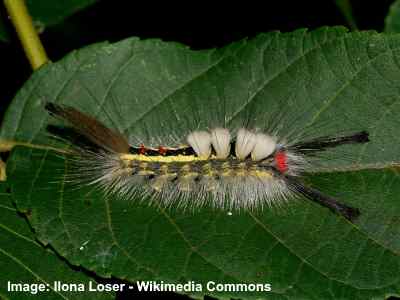
White-Marked Tussock Caterpillar (Orgyia leucostigma)
The white-marked tussock moth caterpillar is one of the most unusually hairy caterpillars you’ll find in Florida. Be careful when handling these spiky caterpillars. They have poisonous glands attached to stinging spines that can cause skin irritation if you touch the fuzzy caterpillar.
The identifying feature of this tussock moth caterpillar is tufts of spiny hairs covering its body. Two long black tufts of pencil-like hairs protrude from the front. In addition, there are four tufts of white or yellow hairs on its back and two red dots at its rear end. White feathery spines also stick out from its sides.
Florida Caterpillar Identification
Identify a white-marked tussock caterpillar by a black body with black and white hairy spines, yellow bands along its back, and a bright cluster of red hairs at its head.
- Adult Stage: Orgyia leucostigma is a species of moth commonly known as the White-Marked Tussock Moth.
- Host Plants: White-Marked Tussock Moth caterpillars feed on a variety of trees and shrubs, including but not limited to oak, hickory, elm, and maple.
- Stinging: The caterpillars of Orgyia leucostigma have urticating hairs that can cause skin irritation and potentially leading to itching and a rash.
American Dagger Moth Caterpillar (Acronicta americana)
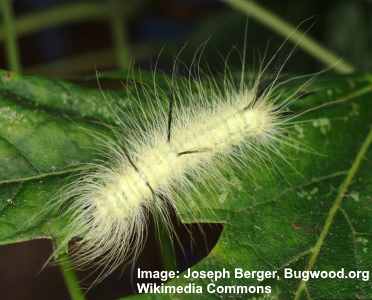
American dagger Moth Caterpillar (Acronicta americana)
The American dagger caterpillar is a hairy pale yellow caterpillar with long black pencil hairs. Under the fuzzy yellow hairs is a shiny black oval head. The spiny hairs are also urticating, meaning they will cause itching or dermatitis if they break off and stick in your skin. You’ll find these furry yellow caterpillars feeding on hickory, maples, birch, and oak leaves.
Florida Caterpillar Identification
The American dagger moth caterpillar is covered in yellow feathery spines with two pairs of long black spines on its back and a single black tuft of pencil-like hairs at its rear. American dagger moth caterpillars grow up to 2” (5 cm) long.
- Adult Stage: Acronicta americana is a species of moth commonly known as the American Dagger Moth.
- Host Plants: American Dagger Moth caterpillars feed on various deciduous trees, including but not limited to birch, elm, maple, and oak.
- Stinging: The caterpillars of Acronicta americana possess urticating hairs that can cause skin irritation upon contact.
Banded Woolly Bear Caterpillar (Pyrrharctia isabella)
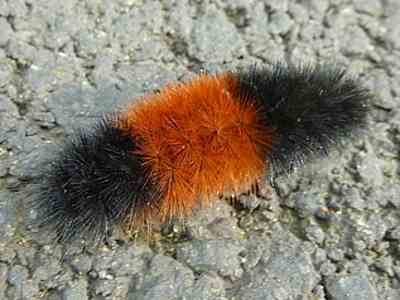
Banded Woolly Bear Caterpillar (Pyrrharctia isabella)
The banded woolly bear caterpillar is a black and brown hairy caterpillar that is common in Florida. The characteristic trait of this furry caterpillar is a wide rusty brown band around a black body. The oblong appearance and fuzzy spines make it difficult to identify the head end from its tail end.
Although it looks like a stinging caterpillar, the banded woolly bear doesn’t sting and isn’t poisonous.
Florida Caterpillar Identification
A banded woolly bear caterpillar is easy to identify due to the two black bands at its head and tail ends and a brown band around its middle.
- Adult Stage: Isabella tiger moth, a medium-sized moth with orange and black wings
- Host Plants: Various plants, including grasses, clover, low-growing vegetation, and weeds including plantain, dandelion, and nettles
- Stinging: No, they do not have stinging hairs. But the bristles can cause skin irritation but are not poisonous
Giant Leopard Moth Caterpillar (Hypercompe scribonia)
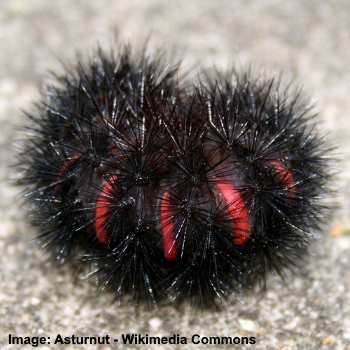
Giant Leopard Caterpillar (Hypercompe scribonia)
The giant leopard caterpillar is a black spiny caterpillar that is common in the south-eastern United States. The black caterpillar has recognizable red bands visible in between sharp spines. The giant leopard caterpillar has a fuzzy appearance, and its spiked body can be painful if the spines jag your skin.
Florida Caterpillar Identification
You can identify the giant leopard caterpillar by its sharp black spine and red band around its body. This caterpillar has a characteristic trait of rolling up to defend itself. Giant leopard caterpillars grow up to 2” (5 cm) long.
- Adult Stage: The caterpillar transforms into a beautiful moth known as the giant leopard moth (Hypercompe scribonia). The adult moth is striking, with its black-and-white spotted pattern on its wings.
- Host Plants: The caterpillar feeds on a variety of plants, including dandelions, clover, violets, and other herbaceous vegetation.
Milkweed Tiger Caterpillar (Euchaetes egle)
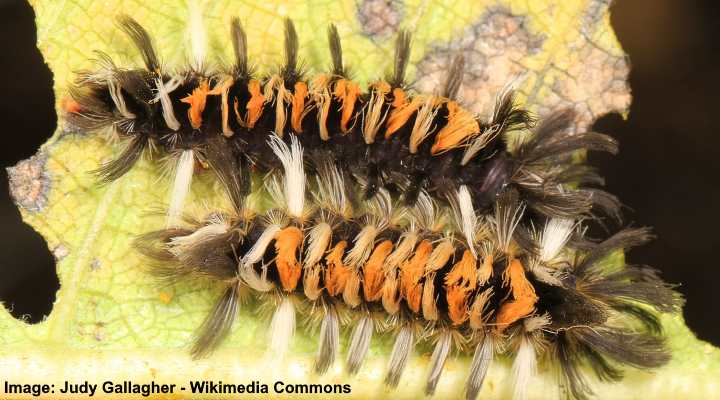
Milkweed Tiger Moth Caterpillar (Euchaetes egle)
The milkweed tiger caterpillar is covered in tufts of colorful black, orange, yellow, and white hairs. In addition, this small furry caterpillar has orangey spiny tufts on its back, tan-colored tufts along its sides, and a hairy brown body. You can spot this caterpillar feeding on milkweed and dogbane plants.
Florida Caterpillar Identification
The unusual milkweed tiger caterpillar is identified by clumps of orange, white, and light brown hairs covering its body. Milkweed tiger caterpillars grow 1.4” (3.5 cm) long.
- Adult Stage: Euchaetes egle is a species of moth commonly known as the Milkweed Tiger Moth. The adult moths are recognized for their vibrant colors and patterns.
- Host Plants: Milkweed Tiger Moth caterpillars feed on various plants, primarily milkweed species (Asclepias spp.), using them as their main food source during their larval stage.
Stinging Caterpillars in Florida (With Pictures) – Identification Guide
Saddleback Caterpillar (Acharia stimulea)
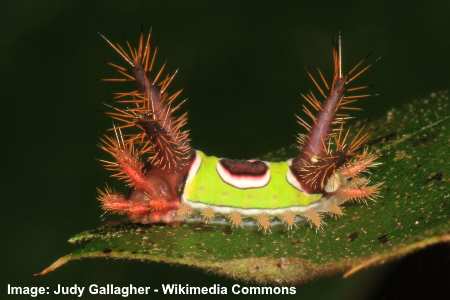
Saddleback Caterpillar (Acharia stimulea)
The saddleback caterpillar is a slug-like caterpillar with large spiked poisonous horns that can give a nasty sting. Saddleback caterpillars get their name from their saddle-like marking—a square green patch with a large brown circle in the middle. The menacing stinging horns at either end of the caterpillar stand at 45°. There is also a row of stinging spines around its abdomen.
The sting from Saddlebacks come from the urticating spines on the horns and rest of its body. These venom-filled hairs can cause a painful sting resulting in a rash and possible nausea.
Florida Caterpillar Identification
The saddleback caterpillar is easy to identify due to its unusual green and brown saddle marking, two spiny horns at either end, and two yellow eye-like markings on its head. Saddleback caterpillars grow up to 1” (2.5 cm) long.
- Adult Stage: Acharia stimulea is a species of moth commonly known as the Saddleback Caterpillar Moth.
- Host Plants: Saddleback Caterpillar Moth caterpillars feed on a variety of trees and shrubs, including but not limited to apple, oak, cherry, and rose.
- Stinging: Has venomous spines that can cause skin irritation upon contact, resulting in a painful rash and localized swelling.
Io moth caterpillar (Automeris io)
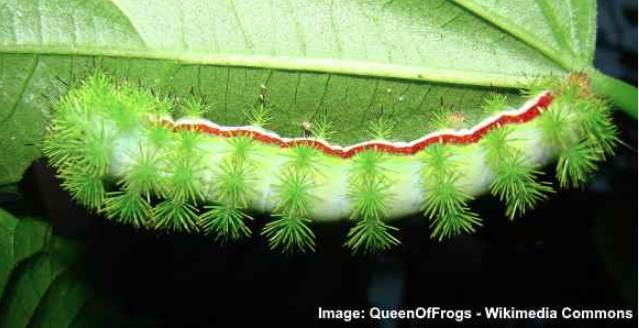
Io Moth Caterpillar (Automeris io)
The Io moth caterpillar is a green stinging caterpillar that you can find in Florida. The pale green caterpillar has bands of bright green urticating tufts around its abdominal segments. You will also notice a red and white stripe along each side. There are also stinging hairs on its four sets of prolegs.
If you spot one of these large green caterpillars, you are best advised to stay clear. The Io caterpillar is a stinging insect and its poisonous spikes will give you a bee-like sting. Although the sting won’t kill you, it can hurt and may even cause an allergic reaction.
Florida Caterpillar Identification
An Io moth caterpillar has an identifiable green body, tufts of urticating spines, and a colorful red and white stripe running the length of its body just above its legs. Io moth caterpillars grow up to 2.3” (6 cm) in length.
- Adult Stage: Io Moth
- Host Plants: Various trees and shrubs including oak, hickory, and elms
- Stinging: Has venomous spines that can cause skin irritation, resulting in a painful rash and swelling upon contact
Southern Flannel Moth (Asp) Caterpillar (Megalopyge opercularis)
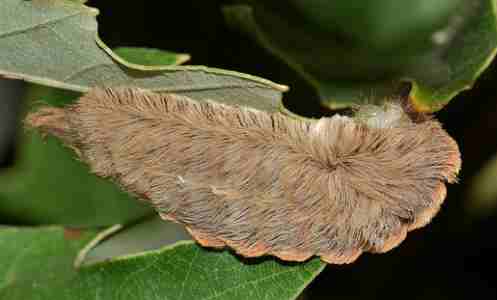
Southern Flannel Caterpillar (Megalopyge opercularis). It is also named puss moth caterpillar.
The southern flannel caterpillar (or puss caterpillar) is a type of venomous and stinging caterpillar found in Florida. It can cause a nasty sting if you handle it. Although its hairy body looks soft, venomous spines lurk underneath and can break off in your skin, causing severe pain. You can find the furry puss caterpillars in most southern states, including Florida.
The southern flannel caterpillars are covered in setae that look like messy beige-orange hair. Some say that this species looks like a tiny Persian cat. Some species have vibrant orange ‘hair’ and others have a grayish or beige speckled black appearance.
The southern flannel caterpillar also has the common name puss caterpillar because it looks like a Persian cat. Additionally, it is called an asp caterpillar because the painful sting can be as excruciating as a snake bite.
Florida Caterpillar Identification
A southern flannel caterpillar has a brown furry appearance with a broad rounded head that tapers to the tail end. Southern flannel caterpillars grow up to 1” (2.5 cm) long.
- Adult Stage: Southern Flannel Moth
- Host Plants: Various trees and shrubs including oak, hickory, and elm
- Stinging: It is considered dangerous due to its nasty sting. The toxicity of the caterpillar’s sting increases with its body size. Symptoms from the sting of the caterpillar can vary in severity and may include headache, nausea, fever, and seizures. In addition, touching them can cause a burning sensation and a rash.
Monkey Slug Caterpillar or Hag Moth (Phobetron pithecium)
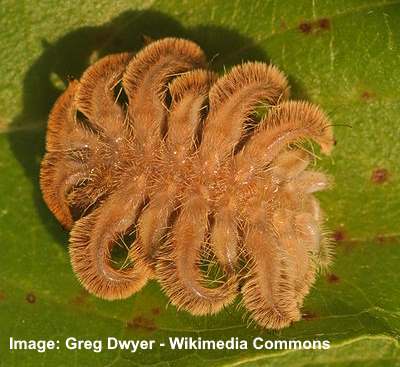
Monkey Slug Caterpillar (Phobetron pithecium)
The monkey slug caterpillar is one of the most unusual brown hairy caterpillars you’ll find in Florida. The caterpillar has a flattened hairy body with nine pairs of strange-looking projections from its sides. The distinctive caterpillar can look like a dead hairy spider or old leaf.
Monkey slug caterpillars have stinging hairs that can cause a painful sting if you handle it.
Florida Caterpillar Identification
It’s easy to identify a monkey slug caterpillar because there is no other insect larva like it. Its body looks like a squashed hairy spider with leg-like protrusions of various sizes along its sides. The tiny brown hairy caterpillars grow up to 1” (2.5 cm).
- Adult Stage: Monkey Slug Caterpillar transforms into the Hag Moth (Phobetron pithecium).
- Host Plants: The caterpillar feeds on a variety of trees and shrubs including oak, chestnut, dogwood, sassafras and ash.
- Stinging: The caterpillars of Phobetron pithecium possess bristles that can cause skin irritation upon contact, often leading to localized itching, swelling, and discomfort in some individuals.
Buck Moth Caterpillar (Hemileuca maia)
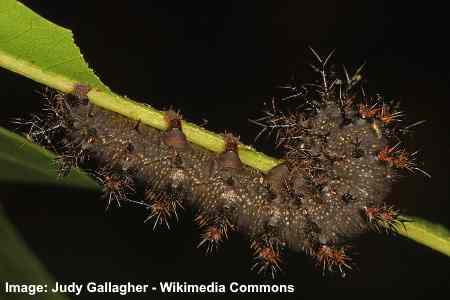
Buck Moth Caterpillar (Hemileuca maia)
The large buck moth caterpillar is among the largest stinging caterpillars in Florida. The caterpillar’s white-spotted black body is covered in jagged tufts of spines. The multi-branched spines contain toxins that can sting if they break off in the skin. The buck moth caterpillar also has a rounded shiny black head.
According to reports, the poisonous spines contain toxins that produce pain if they sting someone. The skin can become red and swollen, and the symptoms can last between one and seven days. Therefore, it’s always best never to handle a buck moth caterpillar to avoid its painful sting.
Florida Caterpillar Identification
A buck moth caterpillar is easy to identify by its black color, masses of white tiny spots, and jaggy appearance. However, there can be color variations, with some buck moth caterpillars appearing mostly white or brown. These large stinging caterpillars grow up to 2.5” (6.5 cm) long.
- Adult Stage: Buck Moth Caterpillar transforms into the Buck Moth (Hemileuca maia)
- Host Plants: The caterpillar feeds on a variety of plants, including oak, hickory, and other hardwood trees
- Stinging: The caterpillars of Hemileuca maia possess spiny projections that can cause skin irritation upon contact, often leading to localized itching, swelling, and discomfort in some individuals.
Spiny Oak Slug Caterpillar (Euclea delphinii)
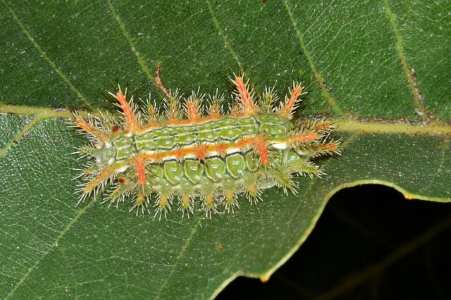
Spiny Oak Slug Caterpillar (Euclea delphinii)
The spiny oak slug caterpillar is a colorful larva with jagged spikes around its body and four pairs of upward-pointing spiked orange horns. The stinging spiny oak slug caterpillar has two orange bands along its back and circular green and white patterns. In addition, the ovoid-shaped caterpillar has venomous spiny poison-filled tubercles that can sting.
Florida Caterpillar Identification
The spiny oak slug caterpillar has a recognizable green body with three pairs of large spikes with black-tipped spines at the head and two similar horn-like spines at the rear. Additionally, there are small clumps of green or orange spines along its back and body. Spiny oak caterpillars are 0.8” (2 cm) long.
- Adult Stage: Spiny Oak Slug Caterpillar transforms into the Spiny Oak Slug Moth (Euclea delphinii)
- Host Plants: The caterpillar primarily feeds on oak and other hardwood trees
- Stinging: The tufts of toxic spines sticking out around the sides are the stinging part of this caterpillar. There are also venomous horns at either end as well as on the back.
Stinging Rose Caterpillar (Parasa indetermina)
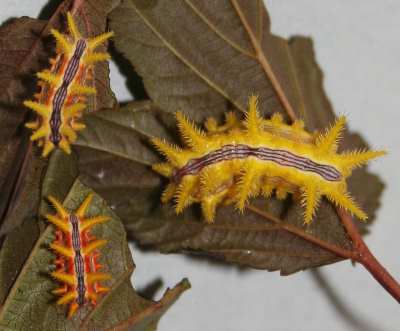
Stinging Rose Caterpillar (Parasa indetermina)
The stinging rose moth caterpillar is a colorful venomous caterpillar found along the east coast from New York to Florida. The spiny caterpillars can be yellow or orange-red and have a distinctive band of thin purple stripes along their back. Look for jaggy horn-like upward-pointing spikes along its back and small clumps of spines along its sides.
It’s best to avoid handling stinging rose moth caterpillars because the venomous spines can cause redness and skin irritation.
Florida Caterpillar Identification
A stinging rose caterpillar has a yellow or red body with characteristic spiked horns on its back and a band of purple stripes. Stinging rose larvae measure about 1” (2.5 cm) long.
- Adult Stage: Stinging Rose Caterpillar transforms into the Rosy Maple Moth (Dryocampa rubicunda).
- Host Plants: The caterpillar feeds on a variety of plants, including roses (which accounts for its common name ‘stinging rose’), as well as elm trees, dogwood, apple, cherry, oak, poplar, maple, hickory, and bayberry
- Stinging: Brushing against this type of caterpillar can leave you with an itchy, irritating rash.
Related articles:
